A file transfer protocol (FTP) is a traditional network protocol that facilitates the transmission of files from one location to another. In addition to file transfer operations, it provides users with a simple way to execute a number of file management functions, including downloading, uploading, editing, and deleting files.
As an application layer protocol, FTP transmits over Transmission Control Protocol/Internet Protocol (TCP/IP) connections and is built on a two-way client-server architecture.
Depending on how tech-savvy you are, it typically takes only about five minutes and three steps to download, set up, and start using an FTP client on your website—and there are many reasons why you might benefit from using FTP to manage a website.
Building a website involves lots of files and folders
A good rule of thumb in software development is to design, code, and test things out on your local system before transferring files to a website or remote repository.
This is why FTP is ideal for everything from web hosting and design to development and maintenance—because it facilitates and streamlines the continuous creation, modification, and transfer of web pages from local and remote websites. It also comes in handy when troubleshooting and fixing HTTP errors quickly.
Furthermore, FTP can help you keep the inherently complex process of website development (and its maintenance) both organized and seamless.
FTP has become the standard practice
FTP is now the standard for transferring and organizing files between two systems. Consequently, FTP applications boast several features that facilitate file and folder processes, such as creating, editing, modifying, renaming, deleting, and permissions-setting.
FTPs serve many useful purposes, including:
- Creating static and dynamic websites
- Facilitating front-end and back-end development
- Posting content to remote host platforms
FTP makes file transfer more secure and efficient
While FTP isn’t as secure as its peers like FTPS and SFTP, it still offers improved protection from manual copy-and-paste processes. It also mitigates failures by ensuring your files are transferred efficiently, and it even provides improved privacy by allowing users to create multiple access levels.
Popular FTP clients
FTP clients are desktop apps with graphical user interfaces and a collection of features for performing file transfer and management operations. Most handle the basic functions of file transfer pretty well. Some, however, offer advanced features for targeted needs, making them more useful than others.
The best FTP clients offer many or all of the following characteristics and benefits:
- User-friendliness and ease of use
- Flexible transfer procedures
- Progress tracking and replication
- Process automation
- Backup services
- Data access and loading
Some of the most popular FTP clients are:
- FileZilla—An open-source client with multi-platform functionality with options for different operating systems, including Windows, Mac, and Linux. It is easy to use, although it has an outdated interface.
- WinSCP—A very popular and easy-to-use Windows FTP client that supports SSH and SFTP. WinSCP also provides an interactive scripting console to automate tasks.
- Cyberduck—In addition to FTP functionality and encryption (Cryptomator) for Mac and Windows users, Cyberduck provides external storage via Dropbox and Google Drive. Compared to most FTPs, Cyberduck boasts a modern and sophisticated interface.
- Forklift—This is a more advanced FTP than its contemporaries and is designed for Mac computers. However, unlike the others on our list, it isn’t an open-source client, so you need to purchase a license to use it.
- Free FTP—This Windows FTP has both free and paid versions. The latter is called Direct FTP, providing folder bookmarks, a code editor, and an image viewer. General features include high-speed transfer and various management tasks.
Most FTP clients have a small digital footprint; it typically only takes a few minutes to download and start using one on your website.
The Benefits of Using An FTP
Apart from the advantages of uploading, downloading, modifying, and managing files on a remote server from a local system, there are several other reasons to use an FTP.
- FTP is supported on almost all hosts.
- It provides the ability to schedule and automate file transfers.
- It optimizes the effective management of transfers, like resuming operations when the connection is lost and then reestablished, for example.
- You can execute bulk file operations so that items can be uploaded and downloaded sequentially, which is especially useful for large file transactions.
- It has virtually no size limitations on file transfers. However, beware that the larger the file, the longer the file transfer will take, as this risks OutOfMemory and ReadTimeout errors on your FTP server.
- FTP is faster than HTTP(s) and email alternatives.
- It provides synchronizing features that work in the background to ensure files on the local and remote systems are similar.
How to Connect to Your Website with FTP
Although it requires an above-average level of computer literacy, you don’t have to be a tech guru to use an FTP. However, you must adequately grasp the basic terminology and architectural template to use an FTP.
FTPs operate on a client-server model that requires establishing a two-way communication channel between two computers. The client system or local host is the end user’s computer that initiates the connection.
On the other end, the system known as the remote host is typically a server—aptly called the FTP server. For everything to run smoothly, the host should have FTP software that’s compatible with your FTP client.
Similarly, your website must also have active and reliable TCP/IP connectivity to facilitate FTP communication. That way, a communication data channel can establish “hand-shaking” between the FTP client and server while controlling the interaction for file transfer.
If you don’t already have one, you’ll need to download an FTP client compatible with your operating system that synchronizes with the server where your website is hosted.
General steps and procedures to connect to your website with FTP
- Download an FTP client—This is the initial process if you haven’t done so already. Make sure your remote server is compatible with the FTP client you choose.
- Check your FTP login credentials and settings—Although some FTP platforms permit anonymous FTP that doesn’t require the client to identify itself to the server (no login credentials required), using this approach is not advised. FTP logins include username and password combinations for authentication.
- Connect to the server. There are several ways you can choose to establish an FTP connection. Some servers and clients enable you to bolster security by changing the connection type to “FTP over SSL/TLS explicit,” although this option is usually turned off by default.
- Check folder permissions. Once you connect to the server, you should see the files you can access, as most FTP interfaces have a file-managing type of setup for you to select the files and folders to work on. If you have problems or issues, double check to make sure you have the authorization to perform the actions you seek on the selected file or folder.
FileZilla Setup Guide
FileZilla is a good client for illustrating the FTP setup process, as it has been battle-tested for over 20 years while catering to the needs of many diverse users on Windows, macOS, and Linux. It isn’t available on ChromeOS, though.
More importantly, however, it is user-friendly, intuitive, and easy to use.
Step 1. Download FileZilla.
Navigate to the platform’s website via https://filezilla-project.org/.
Select the client option for download, assuming you don’t intend to install the FileZilla on a server.
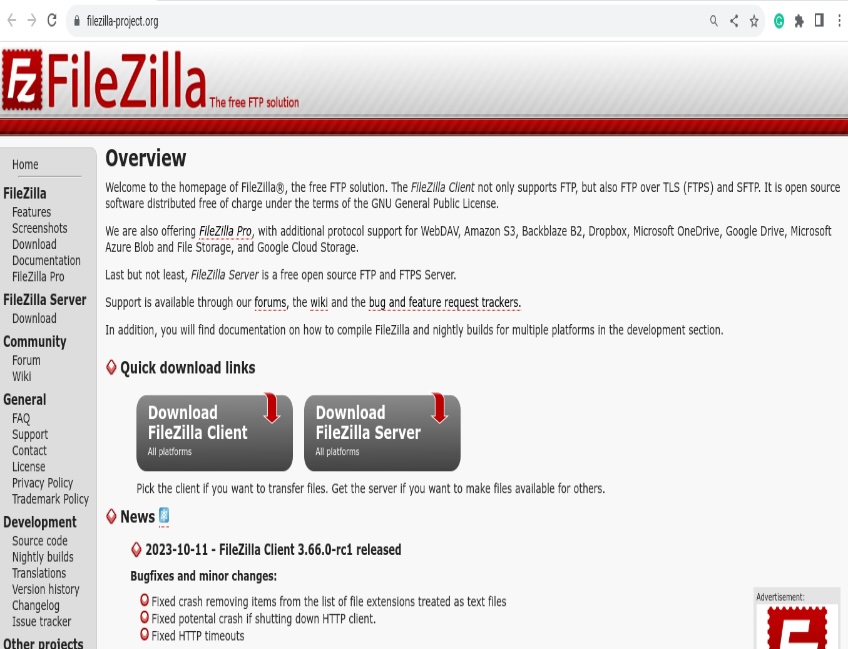
Step 2. Select the FileZilla Client for your OS.
The software will typically detect and navigate to the FileZilla client compatible with your computer’s operating system. Otherwise, you can manually select the appropriate FileZilla software. Beneath the Download FileZilla Client button, you’ll see a More download options section, which provides downloads for other OS options.
By clicking on the Show additional download options link underneath, you’ll navigate to a page that lists the latest stable version of FileZilla operating systems supported, such as Windows (64 bit x86), Windows (32 bit x86) and Linux variants, including source code downloads.
After selecting the OS compatible with your system, click the Download FileZilla Client button to initiate the download.
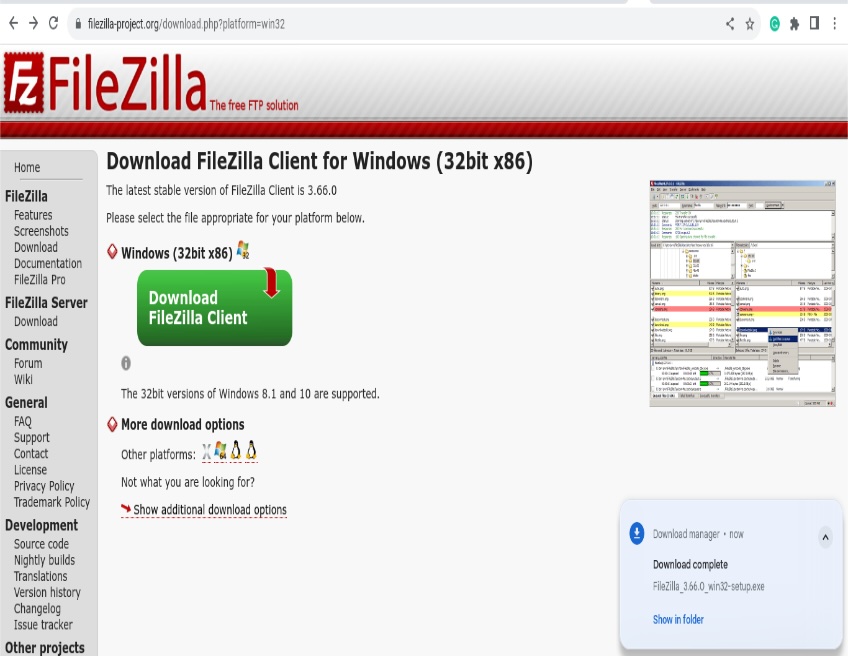
Step 3. Run the downloaded file.
According to the client installation documentation, FileZilla provides three download options: installer, zip, and source code version. However, the installer is the default option. Therefore, if you have downloaded an executable file that’s compatible with your OS, double-clicking or running the installer should launch the installation wizard.
Open the folder where the downloaded file is located and run the downloaded file. If you downloaded the installer, the FileZilla wizard will guide you through the process.
Step 4 Follow the wizard’s instructions to complete the installation.
Depending on the version of your operating system, you’ll see different confirmation prompts from the wizard. Answer the necessary prompts provided, for instance, by accepting the license agreement and choosing your preferred FileZilla components.

The wizard allows you to select the components you want to install. For instance, if you want to have FileZilla’s icon installed on your desktop as a shortcut to the application, check the box.
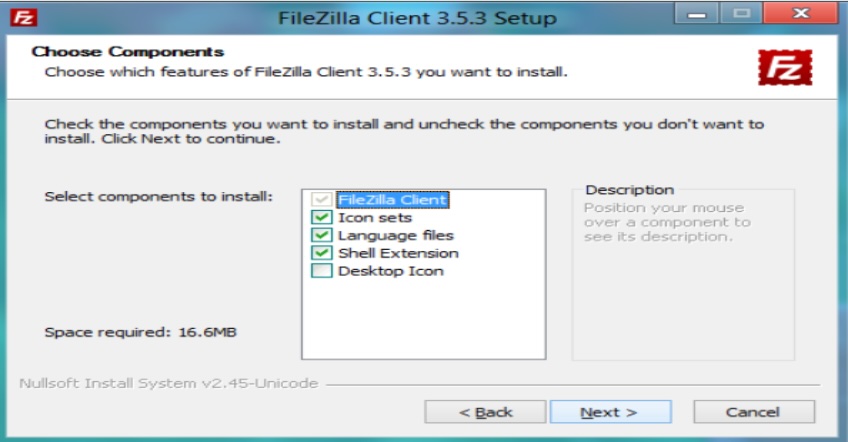
After the setup and installation is complete, you can proceed to launch FileZilla.
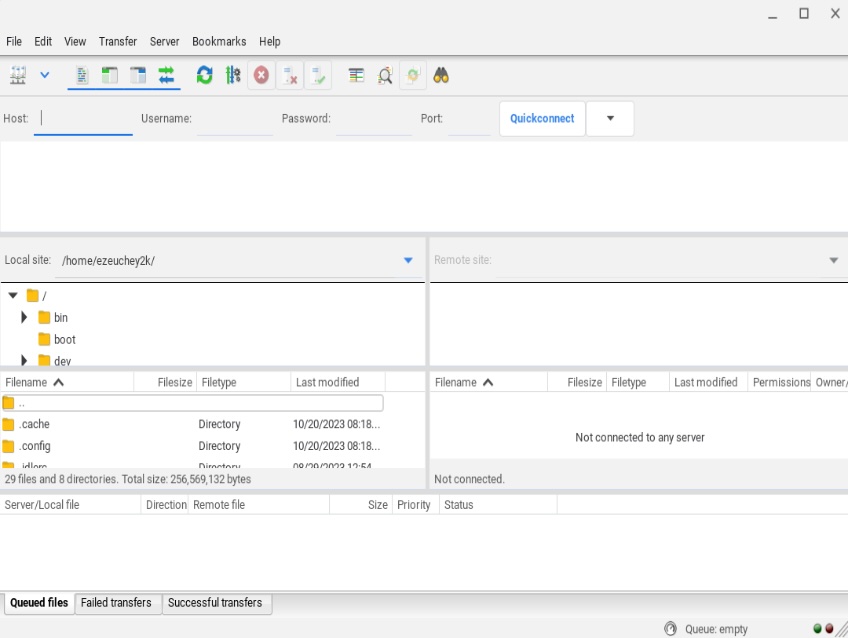
If you want to view the version of your FileZilla client and associated installation details, click on the Help > About menu option.
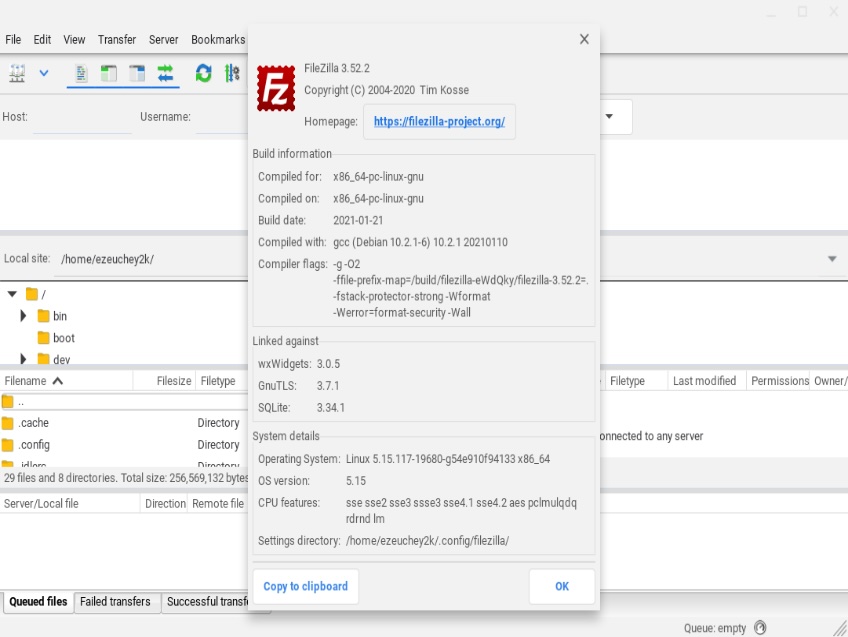
Installing FileZilla via a terminal/command line app on Linux or Chrome OS
This process is even faster than downloading from the website and requires fewer steps.
Open a terminal or command prompt app on your system. Before you start the installation process, make sure your Linux or Chromebook system is up-to-date with the latest software patches.
To do so, type sudo apt-get update on the command line of your terminal.
Technically, updating your software isn’t part of the FTP setup process, but it has become an accepted practice whenever you are installing new software.
Next, type sudo apt-get install filezilla on the command prompt of your terminal.
The process will notify you of the disk space the FileZilla download will consume. Pressing the Y button for yes will proceed with the installation.
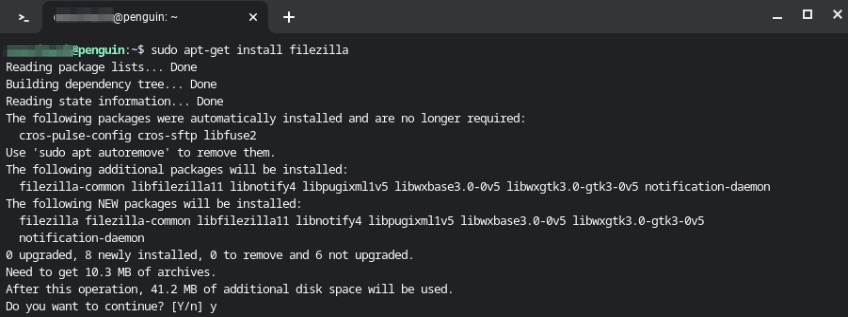
Once the installation has completed successfully, you should find the FileZilla icon on your system’s Desktop or Chromebook Launcher.
When to Use SFTP vs. FTP?
While FTP provides significant benefits, there are occasions when you need a secure way of uploading files to avoid malicious cyberattacks such as snooping, tampering, or man-in-the-middle attacks.
This is where SFTP (secure file transfer protocol) comes to the rescue. SFTP uses secure shell (SSH) encryption to provide a much higher level of security than FTP to transmit files to a remote host.
When should people use SFTP?
Unlike SFTP and FTPS (which we’ll discuss momentarily), FTP lacks encryption and transmits username and password credentials in clear text. As a result, it is very susceptible to simple hacking techniques with basic sniffing tools.
Conversely, SFTP encrypts your commands, credentials, and data during transmission. Moreover, SFTP uses packet-based transmission rather than text-based. SFTP also bolsters security with multi-factor authentication using server or SSH key-based authentication.
If security is a premium for you and you deal with sensitive data such trade secrets, intellectual property, and proprietary information, then SFTP is your best bet.
Not surprisingly, enterprises typically use SFTP because it helps them maintain regulatory compliance with statutes found in HIPAA, GDPR, and PCI DSI.
When should people use FTP?
Many people continue to use FTP despite the security vulnerabilities it exposes them to. One of the major reasons is that FTP enables the smooth transmission of large file transfers with no limits for size.
This is crucial because services like email prohibit users from sending files above a certain size. In addition, FTP is more convenient and faster than email or other common online protocols, like HTTP(S).
On the other hand, SFTP tends to be slower than FTP due to its in-built security protocols. As a result, SFTP is not always ideal for facilitating large file or data transfers.
Furthermore, FTP is easy to use with a minimal learning curve. It is also one of the oldest protocols, so many people are already familiar with it.
Nevertheless, due to its security risks, FTP should only be used within the confines of controlled, secure networks, like virtual private networks (VPNs) or local area networks (LANs).
When to Use FTPS vs FTP?
FTPS stands for FTP-SSL. It is an improved extension of the FTP to support Transport Layer Security (TLS) and SSL (Secure Sockets Layer). Thus, FTPS is essentially FTP over top of SSL/TLS.
When should people use FTPS?
FTPS is a safer form of FTP, so it should be used as a high-order security version of FTP. It’s good for people who want to control and manage more sophisticated cybersecurity protocols.
This includes the mechanism to verify an FTP’s server identity to prevent users from being duped into connecting to fake FTP servers. FTPS accomplished this by incorporating encryption and digital certificates.
Is FTPS more secure than SFTP?
While FTPS and SFTP are built to facilitate secure transmissions, they each adopt different approaches, primarily through their underlying architecture. For example, SFTP is designed to be inherently secure, with in-built security and full encryption as its core features. On the other hand, FTPS has security tacked on, with its encryption and SSL layered on top of it.
As a result, FTPS is less secure than SFTP. For these reasons, many businesses prefer SFTP—which also works well with firewalls, despite how its logging leaves much to be desired.
